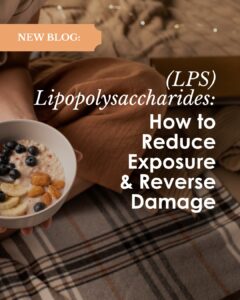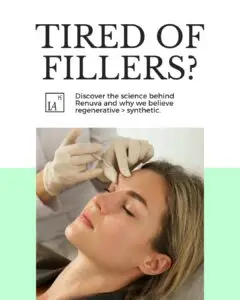
Lipopolysaccharides (LPS): How to Reduce Exposure and Reverse Damage
Health Over Trends Lipopolysaccharides (LPS): How to Reduce Exposure and Reverse Damage What you’ll learn: Discover how lipopolysaccharides (LPS) drive
Dermal fillers are a popular aesthetic treatment, with promises of immediate facial rejuvenation and volume restoration. At IA-h, however, we’ve chosen not to offer them—and here’s why.
Fillers, often Hyaluronic Acid (HA) based, are effective for quick results in areas like lip volume or facial contouring. Many injectors tell you the effects last 9-24 months. However, long-term safety isn’t guaranteed. Despite being widely used for about 15 years, the long-term effects of filler use are only now becoming evident in patients who’ve used it over many years.
What You’re Not Being Told
HA is naturally found in our skin, joints, and even eyeballs, giving hydration and plumpness. But the HA in fillers isn’t the same. Manufacturers cross-link the molecules, modifying the HA to prevent quick breakdown, allowing it to last longer in the body. While this provides longer-lasting effects, it can also lead to tissue expansion. Expanded skin doesn’t return to its original state, much like skin stretched from weight gain. Over time, this can result in sagging and weakened skin.
The Long-Term Consequences
Recent studies are revealing that fillers don’t fully dissolve. MRI scans show they can settle in unintended areas, often creating puffiness, especially under the eyes. Additionally, plastic surgeons are noticing muscle texture degradation in patients with long-term filler use. Our facial muscles play a critical role in maintaining our appearance as we age, so this is a significant concern.
The IA-h Approach: Keep It Natural
At IA-h, we’re committed to enhancing skin health from the inside out. Instead of fillers, we focus on science-backed alternatives like Platelet-Rich Fibrin (PRF) and mesenchymal stem cells. These treatments use your body’s own regenerative powers to boost collagen production and skin fullness—without the risks associated with long-term filler use.

Health Over Trends Lipopolysaccharides (LPS): How to Reduce Exposure and Reverse Damage What you’ll learn: Discover how lipopolysaccharides (LPS) drive

GLP-1 inhibitors like Ozempic and Mounjaro support weight loss—but real success requires more than a prescription. Learn how to protect muscle, optimize metabolism, and sustain fat loss.

This blog explores the science behind biological age, how it differs from chronological age, and the role of methylation, metabolism, gut health, and nutrient optimization in promoting longevity.

Whether you’re seeking a more holistic approach, have concerns about toxins, or simply want to explore new options, there are science-backed alternatives for achieving healthier, younger-looking skin.

Health Over Trends Non-Surgical Face Lifts Are In: Is Sofwave the Future of Skin Tightening? What You Will Learn: Non-invasive

In this post, we’ll explain why Halo | IA-h does not offer dermal fillers—and what we use instead to restore facial volume naturally and safely.
Get science backed insights sent straight to your mailbox.